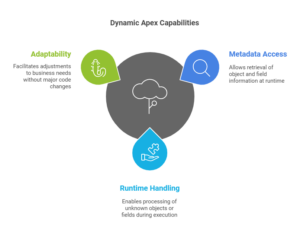Unveiling the Magic of Dynamic Apex in Salesforce: A Beginner’s Journey
Imagine you’re standing in a bustling marketplace where every stall is unique, and the shopkeepers allow you to create your own shopping list dynamically. One moment, you’re buying groceries; the next, you’re adding electronics without breaking a sweat. Now, picture this concept in Salesforce—a flexible way to access, manipulate, and interact with your metadata and sObjects without rigid, predefined structures. Welcome to the exciting world of Dynamic Apex in Salesforce!
In this blog, let’s embark on a journey to understand what Dynamic Apex is, why it’s powerful, and how to harness it, even if you’re just getting started with Salesforce.

What is Dynamic Apex?
Dynamic Apex is like the Swiss Army knife for Salesforce developers. While regular Apex relies on knowing object structures, fields, and methods during compile time, Dynamic Apex allows you to interact with objects and metadata at runtime. Think of it as being able to ask Salesforce, “What fields does this object have?” or “Can you fetch these records dynamically, based on the user’s input?”
This flexibility is incredibly useful in scenarios where requirements are unpredictable or need to adapt based on user behavior.
Why Do We Need Dynamic Apex?
Imagine this scenario: you’re building an application where the fields and objects you work with might vary based on customer-specific configurations. Writing static code for every possible combination would result in a nightmare of maintenance and rigidity. Enter Dynamic Apex! It allows you to:

- Access object and field metadata dynamically.
- Handle unknown objects or fields during runtime.
- Adapt to changing business requirements without extensive code rewrites.
In essence, it helps make your Salesforce solutions future-proof and scalable.
Let’s Dive Into the Basics: Tools of Dynamic Apex
Dynamic Apex is primarily powered by two components:
- sObject Class: Enables dynamic handling of Salesforce objects.
- Schema Class: Provides access to metadata, like object names, field definitions, and more.
Let’s break this down further with examples.
Example 1: Fetching Object Fields Dynamically
Imagine you’re asked to build a component that lists all fields of any object a user selects. With Dynamic Apex, you don’t need to hardcode field names. Here’s how you can do it:
// Getting field names of the Account object dynamically
Schema.DescribeSObjectResult objDescribe = Account.sObjectType.getDescribe();
Map<String, Schema.SObjectField> fieldsMap = objDescribe.fields.getMap();
for (String fieldName : fieldsMap.keySet()) {
System.debug('Field Name: ' + fieldName);
}
Here’s what’s happening:
- getDescribe() fetches metadata about the object.
- fields.getMap() retrieves all fields as a map.
- We iterate through the map keys (field names) dynamically—no hardcoding needed!
Example 2: Querying Records Dynamically
Suppose you want to allow a user to fetch records dynamically based on a field name they provide at runtime. Dynamic Apex lets you craft SOQL queries on the fly:
String objectName = 'Account';
String fieldName = 'Name';
String query = 'SELECT ' + fieldName + ' FROM ' + objectName;
List<sObject> results = Database.query(query);
for (sObject record : results) {
System.debug(record.get(fieldName));
}
Key takeaways:
- The Database.query() method allows dynamic SOQL.
- record.get(fieldName) fetches the value of the field dynamically.
This means users can decide what fields or objects they want to query without any changes to your code.
Common Questions and Answers
Q: Is Dynamic Apex safe?
A : Yes, but it’s essential to handle it with care. Since it allows dynamic code execution, ensure you validate user inputs to prevent unexpected behavior or SOQL injection.
Q: When should I avoid Dynamic Apex?
A : Avoid it for scenarios with fixed, predictable structures. Dynamic Apex can be harder to debug, so use it only when necessary.
Q: Can I use Dynamic Apex with triggers?
A : Absolutely! For example, you can use it in triggers to dynamically fetch metadata about related objects and fields.
Real-World Applications of Dynamic Apex

- Customizable Reporting: Build reports where users can select objects and fields dynamically.
- Data Migration: Fetch metadata to migrate data seamlessly across environments.
- Dynamic Forms: Create forms that adapt based on metadata (e.g., displaying different fields for different record types).
Best Practices for Dynamic Apex
While Dynamic Apex is powerful, it’s essential to use it wisely. Here are some tips:
- Avoid Hardcoding: Use dynamic methods for metadata and sObject manipulation.
- Validate Inputs: Ensure user-provided inputs (like field names) are safe and valid.
- Optimize Performance: Dynamic SOQL can be slower—use it judiciously in performance-critical applications.
Wrapping It Up: Why Dynamic Apex Matters
Dynamic Apex is like giving your Salesforce app the ability to think on its feet. It’s a game-changer for developers who want to build adaptable, scalable, and user-friendly solutions. By enabling runtime flexibility, it opens the door to endless possibilities—from customizable tools to smarter integrations.
As you start exploring Dynamic Apex, remember that it’s not just a tool—it’s a mindset. Instead of asking, “What do I know now?” you’ll begin to think, “What can I discover later?”
So, are you ready to unleash the power of Dynamic Apex and make your Salesforce solutions smarter? Start small, experiment with the examples, and before you know it, you’ll be weaving dynamic magic into your code!


Thanks for sharing. Very informative post.